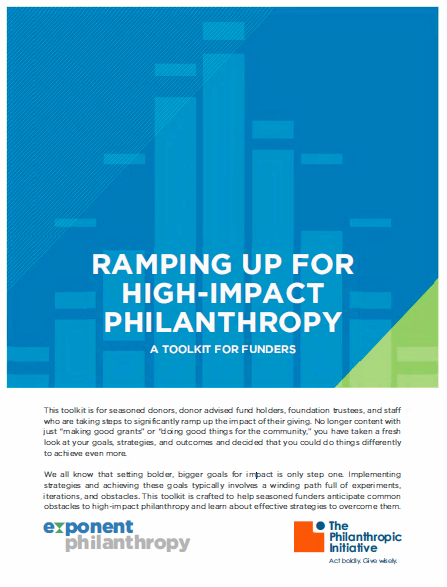
Co-authored by Ali Carley, Senior Program Associate and Ellen Remmer, Senior Partner. This is the second post in the Ramping Up for High-Impact Philanthropy Toolkit series.
Ramping up for high-impact philanthropy isn’t always easy, and often donors face many obstacles along the journey. Through our work with clients, we have identified five common stages on the journey to high impact philanthropy: dynamics and readiness, planning and focus, capacity and implementation, context and collaboration, and learning and adaptation. Determining whether you are prepared to take the first step in the journey requires an assessment of how ready the key stakeholders in your organization (you, your board, your staff) are for the process ahead.
So, how do you know if you are ready to ramp up the impact of your giving? What dynamics and structures should be in place before you launch into this process? Some clients come to us having a broad sense of this. A rare few come to us with meticulous plans and a team of stakeholders that work like a well-oiled machine. Others come to us in periods of chaos and transition, knowing they are not prepared to take this on. However, the majority of clients come to us somewhere in the middle, experiencing a few of the common challenges associated with this stage. These challenges can include disengagement of key decision makers, challenging interpersonal dynamics that get in the way of collaboration, and a lack of shared purpose that prevents the group from moving forward together. Below we give you a glimpse into how we have guided funders – and particularly families – through some of these challenges and leave you with some potential strategies to consider.
Interpersonal Dynamics
While interpersonal dynamics can come into play with all types of funders and companies, this issue can be particularly challenging for families and family foundations. These challenges come in all shapes and sizes. Family members can come to this work with differing opinions of the founding donor’s intent and how to carry out his/her mission; dynamics formed in childhood can make it hard for siblings or cousins to collaborate in a business setting; or perhaps more serious disagreements have created a wedge in the family that make it difficult for members to come together around a shared purpose. We know from experience that thoughtful, deliberate approaches can help bring families together to overcome these challenges. Though each family is different, some of the most successful solutions we have found through our work have included:
- Engaging an experienced facilitator to guide the discussions and decision-making processes during meetings. It is important to have someone who all family members feel comfortable with and trust, and who can also push back on members or help find middle ground when the conversation gets heated.
- Taking detailed notes of meetings and setting up clear processes for how decisions are made. Such clarity and transparency enable stakeholders to trust the process, rather than relying on one another’s memories or interpretations of the conversation.
- Bringing in outside board members or advisors. They can add expertise and a diverse perspective to the board, and their presence at the table can also help diffuse tension among family members and build bridges during meetings.
- Finally, we have encouraged a few clients to hire a family dynamics specialist to work with members on their relationships outside of board meetings. This approach creates a separate space for individuals to air their concerns and disagreements, and to develop agreements about how to work together in the family philanthropy setting.
Engaging Key Decision Makers
Whether or not the interpersonal dynamics are challenging, nearly all families have challenges creating a structure that allows individual stakeholders to engage in a way that is both meaningful and manageable for them. What may be interpreted as lack of engagement from a key decision maker may simply be the result of a very busy life. It could also result from a sense that a family member’s voice isn’t valued, or that the work of the group isn’t aligned with his/her interests and passions. It can be hard to rally everyone to the cause of moving toward high-impact philanthropy, which often takes more time and group work, without first tackling these obstacles. Here are suggestions for how to engage key decision makers:
- Address barriers to engagement. Some stakeholders may have less control over their schedule, for instance, and may only be able to participate in videoconferences or weekend meetings.
- Ensure everyone’s voice is heard. For example, it can be illuminating and constructive to take time in meetings or interviews to ask questions about each individual’s interests and passions, desired level of engagement, and visions for the future of the family’s philanthropy.
- Conduct a strategic planning retreat. Many families find it useful to engage an experienced philanthropy consultant to work with key decision makers to clarify their goals and ambitions for ramping up in impact. This planning process can be highly energizing and help participants understand what it will take to ramp up.
- Build in a “pressure valve” to accommodate personal interests that may not align with the overall strategy. For example, it can be helpful to create a discretionary grant category that allows each trustee a certain amount of funding to allocate on their own.
While these challenges may feel daunting, they are normal. What inspires us is that, as a rule, the families we work with don’t shy away from these challenges. They come to us to help them walk into the eye of the storm and address them head on. Our clients want to achieve greater social impact and honor their family’s legacy, and they come to us determined to find a way to do so. In subsequent blog posts, we will address other obstacles to ramping up, including planning and focus, capacity and implementation, context and collaboration, and learning and adaptation. As noted above, we have focused on families in this blog post but we see these obstacles arise in different ways with other foundations as well as corporate situations. We would love to hear from funders of all types who have stories to share on ramping up the impact of philanthropy – or who are just getting started on this journey!

